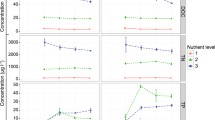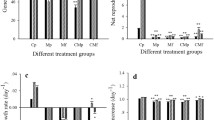Abstract
Nutrient levels, competition from autochthonous microorganisms, and protozoan predation may all influence survival of fecal microorganisms as they transition from the gastrointestinal tract to aquatic habitats. Although Escherichia coli is an important indicator of waterborne pathogens, the effects of environmental stressors on its survival in aquatic environments remain poorly understood. We manipulated organic nutrient, predation, and competition levels in outdoor microcosms containing natural river water, sediments, and microbial populations to determine their relative contribution to E. coli survival. The activities of predator (protozoa) and competitor (indigenous bacteria) populations were inhibited by adding cycloheximide or kanamycin. We developed a statistical model of E. coli density over time that fits with the data under all experimental conditions. Predation and competition had significant negative effects on E. coli survival, while higher nutrient levels increased survival. Among the main effects, predation accounted for the greatest variation (40 %) compared with nutrients (25 %) or competition (15 %). The highest nutrient level mitigated the effect of predation on E. coli survival. Thus, elevated organic nutrients may disproportionately enhance the survival of E. coli, and potentially that of other enteric bacteria, in aquatic habitats.



Similar content being viewed by others
References
USEPA (2006) Water quality standards for coastal recreation waters: using single sample maximum values in state water quality standards, EPA-823-F-06-013. Office of Water, United States Environmental Protection Agency, Washington, DC
Field KG, Samadpour M (2007) Fecal source tracking, the indicator paradigm, and managing water quality. Water Res 41:3517–3538
Harwood VJ, Staley C, Badgley BD, Borges K, Korajkic A (2013) Microbial source tracking markers for detection of fecal contamination in environmental waters: relationships between pathogens and human health outcomes. FEMS Microbiol Rev 38(1):1–40
Boehm AB, Ashbolt NJ, Colford JM Jr, Dunbar LE, Fleming LE, Gold MA, Hansel JA, Hunter PR, Ichida AM, McGee CD, Soller JA, Weisberg SB (2009) A sea change ahead for recreational water quality criteria. J Water Health 7:9–20
Badgley BD, Nayak BS, Harwood VJ (2010) The importance of sediment and submerged aquatic vegetation as potential habitats for persistent strains of enterococci in a subtropical watershed. Water Res 44:5857–5866
Badgley BD, Thomas FI, Harwood VJ (2010) The effects of submerged aquatic vegetation on the persistence of environmental populations of Enterococcus spp. Environ Microbiol 12:1271–1281
Byappanahalli M, Fowler M, Shively D, Whitman R (2003) Ubiquity and persistence of Escherichia coli in a Midwestern coastal stream. Appl Environ Microbiol 69:4549–4555
Davies CM, Evison LM (1991) Sunlight and the survival of enteric bacteria in natural waters. J Appl Microbiol 70:265–274
Ishii S, Ksoll WB, Hicks RE, Sadowsky MJ (2006) Presence and growth of naturalized Escherichia coli in temperate soils from Lake Superior watersheds. Appl Environ Microbiol 72:612–621
Dorevitch S, Ashbolt NJ, Ferguson CM, Fujioka R, McGee CD, Soller JA, Whitman RL (2010) Meeting report: knowledge and gaps in developing microbial criteria for inland recreational waters. Environ Health Perspect 118:871–876
Stoeckel DM, Harwood VJ (2007) Performance, design, and analysis in microbial source tracking studies. Appl Environ Microbiol 73:2405–2415
Barcina I, Lebaron P, Vives-Rego J (1997) Survival of allochthonous bacteria in aquatic systems: a biological approach. FEMS Microbiol Ecol 23:1–9
Feng F, Goto D, Yan T (2010) Effects of autochthonous microbial community on the die-off of fecal indicators in tropical beach sand. FEMS Microbiol Ecol 74:214–225
Korajkic A, McMinn BR, Harwood VJ, Shanks OC, Fout GS, Ashbolt NJ (2013) Differential decay of enterococci and Escherichia coli originating from two fecal pollution sources. Appl Environ Microbiol 79:2488–2492
Korajkic A, Wanjugi P, Harwood VJ (2013) Indigenous microbiota and habitat influence Escherichia coli survival more than sunlight in simulated aquatic environments. Appl Environ Microbiol 79:5329–5337
Mc CJ, McMeekin T (1980) Effect of temperature on activity of predators of Salmonella typhimurium and Escherichia coli in estuarine water. Mar Freshwater Res 31:851–855
McCambridge J, McMeekin TA (1979) Protozoan predation of Escherichia coli in estuarine waters. Water Res 13:659–663
Menon P, Billen G, Servais P (2003) Mortality rates of autochthonous and fecal bacteria in natural aquatic ecosystems. Water Res 37:4151–4158
Staley ZR, Rohr JR, Harwood VJ (2011) Test of direct and indirect effects of agrochemicals on the survival of fecal indicator bacteria. Appl Environ Microbiol 77:8765–8774
Byappanahalli M, Fujioka R (2004) Indigenous soil bacteria and low moisture may limit but allow faecal bacteria to multiply and become a minor population in tropical soils. Water Sci Technol 50:27–32
Wanjugi P, Harwood VJ (2013) The influence of predation and competition on the survival of commensal and pathogenic fecal bacteria in aquatic habitats. Environ Microbiol 15:517–526
LeChevallier MW, McFeters GA (1985) Interactions between heterotrophic plate count bacteria and coliform organisms. Appl Environ Microbiol 49:1338–1341
Staley ZR, Rohr JR, Senkbeil JK, Harwood VJ (2014) Agrochemicals indirectly increase survival of E. coli O157:H7 and indicator bacteria by reducing ecosystem services. Ecol Appl 24:1945–1953
Enzinger RM, Cooper RC (1976) Role of bacteria and protozoa in the removal of Escherichia coli from estuarine waters. Appl Environ Microbiol 31:758–763
McCambridge J, McMeekin TA (1980) Relative effects of bacterial and protozoan predators on survival of Escherichia coli in estuarine water samples. Appl Environ Microbiol 40:907–911
USEPA (2000) The quality of our nation’s waters, EPA841-S-00-001: United States Environmental Protection Agency, Washington, DC
Surbeck CQ, Jiang SC, Grant SB (2010) Ecological control of fecal indicator bacteria in an urban stream. Environ Sci Technol 44:631–637
Anderson IC, Rhodes MW, Kator HI (1983) Seasonal variation in survival of Escherichia coli exposed in situ in membrane diffusion chambers containing filtered and nonfiltered estuarine water. Appl Environ Microbiol 45:1877–1883
Davies CM, Long JA, Donald M, Ashbolt NJ (1995) Survival of fecal microorganisms in marine and freshwater sediments. Appl Environ Microbiol 61:1888–1896
Corno G (2006) Effects of nutrient availability and Ochromonas sp. predation on size and composition of a simplified aquatic bacterial community. FEMS Microbiol Ecol 58:354–363
Corno G, Jürgens K (2008) Structural and functional patterns of bacterial communities in response to protist predation along an experimental productivity gradient. Environ Microbiol 10:2857–2871
Bohannan BJ, Lenski RE (2000) The relative importance of competition and predation varies with productivity in a model community. The Amer Nat 156:329–340
Hall AR, Meyer JR, Kassen R (2008) Selection for predator resistance varies with resource supply in a model adaptive radiation. Evol Ecol Res 10:735–746
Hiltunen T, Laakso J (2013) The relative importance of competition and predation in environment characterized by resource pulses—an experimental test with a microbial community. BMC Ecol 13:29
Matz C, Jurgens K (2003) Interaction of nutrient limitation and protozoan grazing determines the phenotypic structure of a bacterial community. Microb Ecol 45:384–398
Pernthaler J (2005) Predation on prokaryotes in the water column and its ecological implications. Nat Rev Microbiol 3:537–546
Pace ML, Cole JJ (1994) Comparative and experimental approaches to top-down and bottom-up regulation of bacteria. Microb Ecol 28:181–193
Gasol JM (1994) A framework for the assessment of top-down vs bottom-up control of heterotrophic nanoflagellate abundance. Mar Ecol Prog Ser Oldendorf 113:291–300
Gasol JM, Pedrós-Alió C, Vaqué D (2002) Regulation of bacterial assemblages in oligotrophic plankton systems: results from experimental and empirical approaches. A van Leeuw 81:435–452
Thingstad TF (2000) Elements of a theory for the mechanisms controlling abundance, diversity, and biogeochemical role of lytic bacterial viruses in aquatic systems. Limnol Oceanogr 45:1320–1328
Corno G, Jurgens K (2006) Direct and indirect effects of protist predation on population size structure of a bacterial strain with high phenotypic plasticity. Appl Environ Microbiol 72:78–86
Hahn MW, Hofle MG (1999) Flagellate predation on a bacterial model community: interplay of size-selective grazing, specific bacterial cell size, and bacterial community composition. Appl Environ Microbiol 65:4863–4872
Hahn MW, Hofle MG (2001) Grazing of protozoa and its effect on populations of aquatic bacteria. FEMS Microbiol Ecol 35:113–121
Simek K, Chrzanowski TH (1992) Direct and indirect evidence of size-selective grazing on pelagic bacteria by freshwater nanoflagellates. Appl Environ Microbiol 58:3715–3720
Thelaus J, Forsman M, Andersson A (2008) Role of productivity and protozoan abundance for the occurrence of predation-resistant bacteria in aquatic systems. Microb Ecol 56:18–28
Anderson KL, Whitlock JE, Harwood VJ (2005) Persistence and differential survival of fecal indicator bacteria in subtropical waters and sediments. Appl Environ Microbiol 71:3041–3048
Bohannan BJ, Kerr B, Jessup CM, Hughes JB, Sandvik G (2002) Trade-offs and coexistence in microbial microcosms. A Van Leeuw 81:107–115
Marino RP, Gannon JJ (1991) Survival of fecal coliforms and fecal streptococci in storm drain sediment. Water Res 25:1089–1098
Reasoner DJ, Geldreich EE (1985) A new medium for the enumeration and subculture of bacteria from potable water. Appl Environ Microbiol 49:1–7
USEPA (2008) Fate, transport and transformation test guidelines: Simulation test—aerobic sewage treatment: activated sludge units, OPPTS 835.3240/EPA 712-C-08-004: United States Environmental Protection Agency.
Eaton AD, American Public Health A, American Water Works A, Water Environment F (2005) Standard methods for the examination of water and wastewater. American Public Health Association, Washington, D. C
USEPA (2002) Method 1603: Escherichia coli (E. coli) in water by membrane filtration using modified membrane-thermotolerant Escherichia coli agar (modified mTEC). U.S. Environmental Protection Agency. Office of Water, Office of Water, Washington, DC.
APHA (1992) Standard methods for the examination of water and waste water. Washington, D. C
Bolker B (2015) Linear and generalized linear mixed models. In: Fox G, Nagrete-Yankelevich S, Sosa V (eds) Ecological Statistics: contemporary theory and application. Oxford University Press, Oxford
Fox J (2008) Applied regression analysis and generalized linear models, 2nd edn. Sage Publications, Thousands Oaks
Team RC (2012) R: a language and environment for statistical computing. R Foundation for Statistical Computing, Vienna
Cleveland W (1979) Robust locally weighted regression and smoothing scatterplots. J Am Statist Assoc: 829–836.
Jürgens K, Matz C (2002) Predation as a shaping force for the phenotypic and genotypic composition of planktonic bacteria. A van Leeuw 81:413–434
Jousset A (2012) Ecological and evolutive implications of bacterial defences against predators. Environ Microbiol 14:1830–1843
Jürgens K (2007) Predation on bacteria and bacterial resistance mechanisms: comparative aspects among different predator groups in aquatic systems predatory Prokaryotes. Springer, pp. 57–92
Wanjugi P, Harwood V (2014) Protozoan predation is differentially affected by motility of enteric pathogens in water vs. sediments. Microb Ecol 68:751–760
Yao Z, Davis RM, Kishony R, Kahne D, Ruiz N (2012) Regulation of cell size in response to nutrient availability by fatty acid biosynthesis in Escherichia coli. Proc Natl Acad Sci U S A 109:E2561–E2568
Hahn MW, Moore ER, Hofle MG (1999) Bacterial filament formation, a defense mechanism against flagellate grazing, is growth rate controlled in bacteria of different phyla. Appl Environ Microbiol 65:25–35
Harvey WS, AF (1973) Effects of protozoa on the fate of particulate carbon, EPA-660/3-73-007. National Environmental Research Center, Office of Research and Development
Wcisło R, Chróst RJ (2000) Survival of Escherichia coli in Freshwater. Pol J Environ Stud 9:215–222
Lim C, Flint K (1989) The effects of nutrients on the survival of Escherichia coli in lake water. J Appl Microbiol 66:559–569
Francy DS, Stelzer EA, Duris JW, Brady AMG, Harrison JH, Johnson HE, Ware MW (2013) Predictive models for Escherichia coli concentrations at inland lake beaches and relationship of model variables to pathogen detection. Appl Environ Microbiol 79:1676–1688
Frick WE, Ge Z, Zepp RG (2008) Nowcasting and forecasting concentrations of biological contaminants at beaches: a feasibility and case study. Environ Sci Technol 42:4818–4824
Zhang Z, Deng Z, Rusch KA (2012) Development of predictive models for determining enterococci levels at Gulf Coast beaches. Water Res 46:465–474
Zepp RG, M. Cyterski, R. Parmar, K. Wolfe, E. M. White, and M. Molina. (2010) Predictive modeling at beaches, Volume II: Predictive tools for beach notification, EPA-600-R-10-176. National Exposure Research Laboratory, United States Environmental Protection Agency, Washington, DC
Author information
Authors and Affiliations
Corresponding author
Electronic supplementary material
Below is the link to the electronic supplementary material.
ESM 1
(DOCX 129 kb)
Rights and permissions
About this article
Cite this article
Wanjugi, P., Fox, G.A. & Harwood, V.J. The Interplay Between Predation, Competition, and Nutrient Levels Influences the Survival of Escherichia coli in Aquatic Environments. Microb Ecol 72, 526–537 (2016). https://doi.org/10.1007/s00248-016-0825-6
Received:
Accepted:
Published:
Issue Date:
DOI: https://doi.org/10.1007/s00248-016-0825-6




